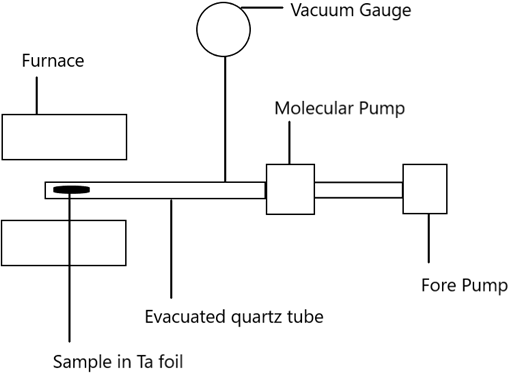This set of Nanotechnology Multiple Choice Questions & Answers (MCQs) focuses on “Synthesis of Nanoparticles”.
1. Which among the following is an advantage of ion implantation method of nanoparticle production?
a) Amorphization of target sample
b) Ion channeling along a particular direction
c) Formation of composite materials containing metal nanoparticles
d) Crystallographic damage in the target
View Answer
Explanation: Ion – implantation method is a process operating at low temperature for the production of ion – implantation induced nanoparticles. This method has several drawbacks such as crystallographic damage, amorphization, sputtering issues etc. However, the major advantage it poses is the formation of composite nanoparticles with various sizes lying in the range of 1nm to 20 nm.
2. Find out a mechanical method used for the synthesis of nanoparticles.
a) Ball Milling
b) Radiolysis
c) Pyrolysis
d) Inert gas condensation
View Answer
Explanation: Ball milling is a mechanical method of preparation of nanoparticles. It is a top – down approach. Macro and micro – scale solid particles can be grinded in a ball mall that uses a size reducing mechanism until enough of the product is in the nanoscale size range.
3. Choose the correct order of the procedure for nanoparticle formation using RF plasma.
a) High temperature plasma formation ➔ Evaporation of metal ➔ Storage of metal in evacuated chamber ➔ Passivation of particles ➔ Introduction of He gas
b) Storage of metal in evacuated chamber ➔ Evaporation of metal ➔ Introduction of He gas ➔ High temperature plasma formation ➔ Passivation of particles
c) Passivation of particles ➔ Introduction of He gas ➔ Evaporation of metal ➔ High temperature plasma formation ➔ Storage of metal in evacuated chamber
d) Introduction of He gas ➔ High temperature plasma formation ➔ Storage of metal in evacuated chamber ➔ Passivation of particles ➔ Evaporation of metal
View Answer
Explanation: Initially the metal is placed in a pestle inside an evacuated chamber. The metal is evaporated using high voltage RF coils wrapped around the evacuated system. Helium is then introduced in the system that generates high temperature plasma near the coils. Metal vapors nucleate on the atoms of He gas and get raised to the colder collector rod where the nanoparticles are formed. These are passivated by the introduction of some gas like oxygen.
4. The wet chemical processes do not leave opportunities for the adjustment of the size of nanoparticles produced.
a) False
b) True
View Answer
Explanation: The size of the nanoparticles produced using the wet chemical processes can be adjusted by choosing the concentration of the reagents and temperature of the solutions. Also addition of suitable inert agents that affect the viscosity and diffusion rate of the liquid can alter the size of nanoparticles.
5. Which method of fabrication of nanoparticles is represented by the given diagram?

a) Wet Process
b) Thermolysis
c) Pulsed laser method
d) Inert gas condensation
View Answer
Explanation: Nanoparticles can be made by decomposing materials at elevated temperature having metal ions, and metal organic compounds. The sample is being placed in an evacuated quartz tube and continuously heated to high temperatures. This decomposes them at a point of time thereby increasing the pressure on the vacuum gauge.
6. What is the purpose of the organic capping agent in the Radiolysis method?
a) Prevents re – oxidation of metals
b) Increases gamma dosage
c) Regulates growth of particles
d) Deactivates the free – radicals in solution
View Answer
Explanation: Radiolysis method of nanoparticle formation makes use of an organic capping agent or surfactant. These substances surround the particle during its formation and control its growth. In greater concentrations, these remain attached to the surface of nanoparticles and inhibit any cluster formation.
7. Inert gas condensation method of nanoparticle production applies sequential growth scheme.
a) False
b) True
View Answer
Explanation: Inert gas condensation method is often used to produce nanoparticles of metals. The metals are evaporated in an inert atmosphere. This is followed by condensation of the super – saturated metal vapors resulting in creation of nanometer size particles. This method uses sequential growth scheme where the particles travel through a second metallic vapor resulting in the growth of core – shell (CS) structure.
8. Name a method used exclusively for the production of silver nanoparticles.
a) Injection moulding
b) Hummer’s method
c) Extrusion
d) Pulsed laser methods
View Answer
Explanation: Pulsed laser have been used in the synthesis of silver nanoparticles. The procedure employs a silver salt such as silver nitrate (AgNO3) and a reducing agent to prepare the nanoparticles. The size of the particles can be regulated by adjusting the energy of the laser and rotation speed of the disk.
9. Which method of production of nanoparticles uses an ultrasonic nozzle spray during the course?
a) Wet process
b) Ion implantation
c) RF Plasma
d) Pyrolysis
View Answer
Explanation: Pyrolysis refers to the thermal decomposition of materials at high temperature in the presence of inert gas. In this method ultrasonic nozzle spray is used in which the precursor liquid is forced through an orifice at high pressure. This leads to the formation of nanoparticles instead of aggregates and agglomerates.
10. In which procedure the treatment of dielectric surface results in nanoparticles?
a) RF Plasma
b) Blow molding
c) Hummer’s method
d) Ion implantation
View Answer
Explanation: Ion implantation method can be used to induce nano – dimensional particles in oxides of dielectric materials such as sapphire and silica. The method employs typical ion beam energies to form the nanoparticles. A wide range of nanoparticles with sizes lying between 1nm to 20 nm can be synthesized alongside composites with implanted species.
Sanfoundry Global Education & Learning Series – Nanotechnology.
To practice all areas of Nanotechnology, here is complete set of 1000+ Multiple Choice Questions and Answers.
If you find a mistake in question / option / answer, kindly take a screenshot and email to [email protected]
